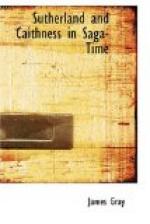On Magnus’ death in 1239, Gillebryd or Gillebride, called in the Icelandic Annals Gibbon, who was either a son or younger brother of Magnus, succeeded Magnus II in the Orkney and Caithness titles and in the Paul share of the Caithness earldom, and it appears from a grant of the advowson of Cortachy on 12th December 1257 that Matilda daughter of Gillebert, “then late Earl of Orkney,” married Malise Earl of Stratherne. On Gillebride’s death in 1256, his son Magnus III succeeded to Orkney and to the share of Paul in the Caithness earldom, as held by Earl Magnus II and Earl Gillebride his successor, that is without the Sutherland earldom, and without Freskin and Johanna’s share of Caithness.
The right to succeed to the other share of Caithness, that of Erlend Thorfinnson, which, according to The Flatey Book had belonged to Jarl Ragnvald, and had been conferred on Harald Ungi by William the Lion in 1197, passed through Ragnhild, another and the youngest sister of Harald Ungi, and then through a child of hers, possibly Snaekoll Gunni’s son, the only known male representative of this line at the time, or through Snaekoll’s younger brother or sister, along with the Moddan estates in Strathnaver and in various highland and Celtic parishes in Caithness, to Johanna of Strathnaver as Ragnhild’s heir; but this share did not carry with it the title of Countess. It was held for her in wardship, but it was not formally granted and confirmed by the Crown to her or her husband Freskin de Moravia, who had become Lord of Duffus by 1248, until their marriage, in or after 1245, or even later, and when the settlement was made, possibly South Caithness was taken partly out of it.
If Earl John had left no daughter at all, the result in Caithness might well have been much the same; for in that case the Caithness title and lands might well have been conferred as to the title and a share of the earldom lands on the elder surviving sister of Harald Ungi, Ingibiorg or Elin, and her heir, while the other share without the title would go to the heir of the younger sister Ragnhild. But Magnus, if he had not married John’s daughter, would not have got North Caithness, and it seems essential that Magnus should have married into the line of Earl John, in order to found a claim on his part to the Jarldom of Orkney, which Harold Maddadson, David, and John (with whom Magnus had no relationship at all, so far as is known) had held in its entirety, in spite of the grant of a moiety of it to Harald Ungi, ever since Harald Ungi’s death in 1198, and to the exclusion of the Erlend line from all share in Orkney, (save for Harald Ungi’s grant) ever since Jarl Ragnvald’s death in 1158.
But who will find evidence to prove our conjectures to be even approximately true?
Till this is done, these matters rest upon mere conjecture, based mainly upon known Scottish policy, the name of “Magnus,” and the probable situation of the lands owned by the parent lines and the families known afterwards to have held them, namely, the families of Cheyne, Federeth, Sutherland, Keith, Oliphant, and Sinclair, among whose writs or inventories of them search might be made.




